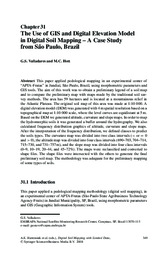The Use of GIS and Digital Elevation Model in Digital Soil Mapping: a case study from São Paulo, Brazil.
The Use of GIS and Digital Elevation Model in Digital Soil Mapping: a case study from São Paulo, Brazil.
Author(s): VALLADARES, G. S.; HOTT, M. C.
Summary: This paper applied pedological mapping in an experimental center of APTA-Frutas in Jundiaí São Paulo, Brazil, using morphometric parameters and GIS tools. The aim of this work was to obtain a preliminary legend of a soil map and to compare the preliminary map with maps made by the traditional soil survey methods. The area has 59 hectares and is located at a mountainous relief in the Atlantic Plateau. The original soil map of this area was made at 1:10 000. A digital elevation model (DEM) was generated with 4m spatial resolution based on a topographical map at 1:10 000 scale, where the level curves are equidistant at 5 m. Based on the DEM we generated altitude, curvature and slope maps. In order to map the hydromorphic soils it was generated a buffer around the hydrography. We also calculated frequency distribution graphics of altitude, curvature and slope maps. After the interpretation of the frequency distribution, we defined classes to predict the soils types. The curvature map was divided into two class intervals (< or = 0 and > 0), the altitude map was divided into four class intervals (690, 703, 704,714, 715, 730, and 731, 757 m), and the slope map was divided into four class intervals (0-9, 10-19, 20-44, and 45-72%). The maps were reclassified and converted to shape files. The shape files were intersected with the others to generate the final preliminary soil map. The methodology was adequate for the preliminary mapping of some types of soils.
Publication year: 2008
Types of publication: Book sections
Unit: Embrapa Territorial
Observation
Some of Embrapa's publications are published as ePub files. To read them, use or download one of the following free software options to your computer or mobile device. Android: Google Play Books; IOS: iBooks; Windows and Linux: Calibre.
Access other publications
Access the Agricultural Research Database (BDPA) to consult Embrapa's full library collection and records.
Visit Embrapa Bookstore to purchase books and other publications sold by Embrapa.

